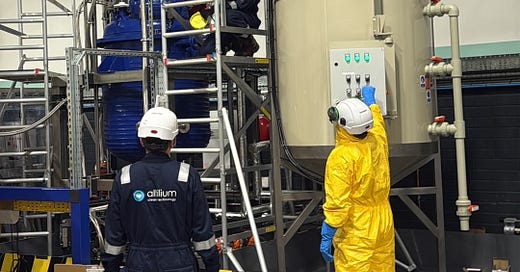New from Old: Start Ups in Recycling part 2
What will it take to get to a circular economy in batteries? Issy takes a look at two early movers in the UK recycling industry.
In the first part of this article, we spoke to a company trying to solve the challenge of wastewater in recycling. In this second part, we flip recycling on its head to talk about supplying materials, since a key motivation behind recycling batteries is the domestic supply chains that it will generate, as well as dealing with waste streams.
In order to hit their aggressive decarbonisation targets, OEMs are going to need to address the upstream emissions in their supply chains in order to lower the battery contribution to the overall vehicle’s emissions. The battery is a serious contributor to life cycle emissions, as shown below in dark blue, and much of that is materials.

Since black mass is essentially a high concentration ore of minerals, it makes a lot of sense to ‘mine’ the black mass to get those high value minerals out, with very little waste or tailings equivalent that you would have in mining. LCA done by Minviro estimates that recycled feedstock could be up to 74% lower in carbon emissions than mined feedstock. This lower carbon process is going to be essential to decarbonising the OEM supply chain and diversifying their supply chain. The hope is that this could reduce an overall EV carbon footprint by up to 25%.
There are several ways to recycle batteries, as detailed below.

Let’s dive into what it takes to recycle black mass in the UK.
Altilium Clean Technology
Altilium is based in Devon in the South West of the UK. The company was incorporated in 2020, and aims to ‘close the loop’ on battery materials. They have a twin focus: enabling circularity in batteries as well as recycling copper and rare earth elements from mine tailings.

Altilium takes black mass from shredded batteries, and uses a hydrometallurgical process to leach out the minerals such as lithium, nickel and cobalt into precursor material. They then produce cathode active material from the recycled metals.
This hydrometallurgical recycling process can recover over 95% of the critical battery metals for direct reuse in new batteries, cutting greenhouse gas emissions by up to 74% compared to mining virgin raw materials.
They have an R&D facility and a small scale commercial plant in Plymouth, an existing solvent extraction and electrowinning (SXEW) plant in Bulgaria which is being retrofitted to process black mass, and plans for a UK recycling plant located in Teesside. Plymouth has capacity to recycle over 200,000kg of batteries per year. Bulgaria will begin operations in 2025, recycling battery waste from 24,000 EVs each year. At Teesside they will be capable of processing 50,000 tonnes of lithium-ion battery black mass a year, to produce 30,000 tonnes of CAM a year or 20% of the UK’s needs by 2030.
We spoke to Dr Christian Marston, COO and Co-founder at Altilium about the company’s journey so far and their plans for the future, as they have just secured $5m USD from Japanese investment group Marubeni Corporation as part of a Series B funding round.
Could you tell us a little about your background and where the idea for Altilium came from?
I have a technical background, with a PhD in Materials Engineering. After a post doc at the University of Southern California I took a commercial role at Sumitomo, a large Japanese company, managing their energy products. So I come at this with a raw materials supply background.
Altilium was started with the motivation to support the UK to get to Net Zero using material science. To electrify transport we need batteries and minerals, and batteries are interesting as we can efficiently recycled them and recover a high percentage of minerals like Lithium, Nickel and Cobalt. The other angle here is we wanted to build a UK domestic champion for battery recycling in order to create high volumes of low carbon materials at high volume
For us coming from the raw materials supply side with experience of mining and processing, we applied a mining logic to looking at black mass as a concentrated ore of these critical minerals. Our baseline flow sheet has come from the mining industry, adapted to black mass. With this mining experience we had a lot of hydrometallurgy processing know-how, which we could apply to recycling these existing waste streams. Hydrometallurgy is key because it’s about scale - we can use fairly standard chemicals which are available at scale to give us high volume of materials.
Could you speak a bit more about the choice to start with hydrometallurgy and how integrated you aim for your system to be?
Our aim is to be able to create full battery circularity - to collecting an end of life battery, moving it to a recycling station and creating black mass, recovering the salts and producing pCAM and CAM that will create a new battery.
We started with the hydrometallurgy part because of the need to build physical infrastructure, but the aim is to build out that upstream piece so we are in the process of ordering facilities to put on scrapyards to shred batteries there. For the moment we take automotive OEM batteries and scrapyard batteries and they are shredded by a third party and the black mass taken to our facilities in Devon.
We have a number of collaborative R&D projects with automotive partners to qualify materials produced at our facilities in Devon, with the support of the Advanced Propulsion Centre and The Faraday Battery Challenge. We are working with Nissan, as part of an APC-backed consortium exploring battery reuse and recycling, and also Jaguar Land Rover, to produce and validate battery cells using our recycled CAM. These cells will be produced at the UK Battery Industrialisation Centre (UKBIC) and JLR will carry out validation studies at its battery testing facilities.
How did you choose your locations and what is their significance?
Our facility in Devon is focused on the development and qualification of our product and process. We chose it because our first process sheet was validated by the Universtiy of Plymouth and our first green tech award was from Devon County Council. Being in the South West of the UK puts us in the heart of this new ecosystem of battery raw materials being built including lithium mining in cornwall, and the Agratas gigafactory in Somerset.
We’re based on the edge of Dartmoor in a town called Tavistock which was built in 1800s in the first industrial revolution for mining tin and copper. It feels significant to be doing urban mining in that same town in this new industrial revolution.
At scale, we needed a chemical park so we chose the home of the UK’s chemical industry in Teesside. This allows us to access optimised permitting and access to low cost green energy which is important since the focus is on decarbonising supply chains.
Our plant in Bulgaria is a historic asset belonging to the shareholders, which was a permitted brownfield solvent extraction and electrowinning plant. We are forunate to have that asset, but we are focused on the UK as a market. Having an asset in Eastern Europe is an interesting strategic location as the area is becoming important for gigafactory production. The Bulgaria plant is still a scale up to the Teesside facility. The recycling industry is very important for domestic supply chains and industrial resilience.
What are your thoughts on the (lack of) UK CAM market and how are you developing Altilium to filling that gap?
If the UK is going to have giga factories and automotive industry it needs to have its own supply chain, and there is no real plan for CAM manufacture in UK. We had an LCA done by Minviro which confirmed that our material is lower carbon than importing from China, and a report by PWC Strategy& suggested that CAM made from recycled content could also lower the cost by 20%.
The first stage at our ACT4 facility will produce battery metal salts at scale, then the second plant which will make pCAM and CAM once our product is qualified with customers. So you can see we are going step by step, as this is a very specialised chemical with a long qualification process.
There’s this positive sense of urgency, there is no 2050 as everything needs to be built by 2030 and there is no time. This new industry is being built and we need to develop the green processing technology and build the infrastructure.
Finally, what do you see as the challenges and advantages to being a first mover in this space?
Building infrastructure is really capital intensive - in the billions. The challenge here is how to articulate that your technology has been derisked. Before an investor will give you money you’ve got to show and prove your flow sheets. We built ACT1 and can show kg level recovery. We’re 11% owned by SQM, the big lithium miners, and we need those kinds of strategic partnerships to allow us to speed up in the UK.
Another challenge with new industries is that you’ve got to build the business models without knowing what they look like. For instance we don’t exactly know who’s going to own the batteries, and post 2030 with regulations there could be a green premium on low carbon and domestic supply material.
This industry is quite unique and different to everything we’ve come from in terms of speed. There is no real time to solve this challenge and we need razor sharp focus on our strategy or goals. If we are going to get to Net Zero we are going to have to think differently, and we apply that to our company culture and values in order to use material science to disrupt the industry.
As a start up we are able to move quicker and be more nimble to push the technology forward than slower incumbents, but we also do need the big companies like SQM supporting the start ups with engineering know how and financial backing. We’ve seen in the us it’s start ups showing the leadership in battery recycling, and the transition allows companies such as altilium to have a purpose and a place, if we kept the status quo there wouldn’t be such opportunities.
🌞 Thanks for reading!
📧 For tips, feedback, or inquiries - reach out
📣 For newsletter sponsorships - click here






